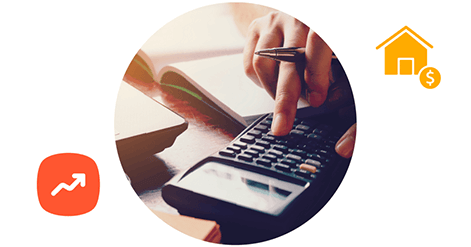How to Calculate and Use Cap Rate: Everything You Need to Know

Are you ready to become a real estate math whiz? Or at least look like one?
Enter the world of cap rates.
Don't worry, you won't need to know advanced calculus for this. In fact, calculating cap rate is a straightforward process; and it's the ultimate tool to help you evaluate the profitability of a real estate investment.
If you're feeling a bit intimidated, don't worry! We've got you covered with everything you need to know about cap rate in real estate investing.
In this blog, we'll break down the concept of cap rate into bite-sized pieces so you can easily understand and apply it to your investment strategy.
Let's dive in!
Why Cap Rate Matters to Real Estate Investors
Interpreting and Using Cap Rate
What is Cap Rate?
Cap Rate Definition
Cap rate, short for capitalization rate, is a financial metric used in real estate investment to evaluate the profitability of a property. It is expressed as a percentage and represents the rate of return an investor can expect to earn on their investment based on the property's net operating income (NOI) and its market value.
In simple terms, the cap rate is a way to determine how much income an investor can generate from a property relative to the price they paid for it.
Relationship between Cap Rate, Property Value, and Net Operating Income (NOI)
The cap rate is a crucial metric for real estate investors because it provides a simple and effective way to evaluate the profitability of an investment property. A higher cap rate indicates a higher potential return on investment, while a lower cap rate indicates a lower potential return.
In general, properties with higher cap rates are usually considered riskier investments because they typically have lower property values or generate less income. Conversely, properties with lower cap rates are seen as less risky investments because they have higher property values or generate more income.
You can use the cap rate to compare the relative value of different investment properties. For example, if two properties have similar net operating incomes but different market values, the property with the higher cap rate would be the better investment.
In addition to comparing investment opportunities, you can also use the cap rate to estimate the potential resale value of a property. By applying the cap rate to the expected net operating income of the property, investors can estimate its potential market value.
Why Cap Rate Matters to Real Estate Investors
Cap rate represents the rate of return an investor can expect to earn on their investment based on the property's net operating income (NOI) and market value. Here are some reasons why cap rate matters to real estate investors:
Cap rate is critical for evaluating potential investments
Cap rate is essential for real estate investors to evaluate potential investments quickly and effectively. By calculating the cap rate for a property, investors can determine its potential rate of return and compare it to other investment opportunities.
Knowing cap rate enables investors to identify properties likely to provide a good return on investment and avoid properties that may not be worth pursuing.
Cap rate helps compare properties and markets
Cap rate is also useful for comparing different properties and markets. For example, investors can use cap rates to compare the relative value of two properties that generate the same net operating income but have different market values. Additionally, you can use cap rates to compare the overall profitability of different markets.
By analyzing cap rates across multiple properties in a given market, investors can get a sense of whether that market is undervalued or overvalued compared to other markets.
Cap rate allows you to assess risk and return
Cap rate is a valuable metric for assessing the risk and return of a real estate investment. Higher cap rates generally indicate riskier investments with potentially higher returns, while lower cap rates indicate less risky investments with potentially lower returns.
Investors can better understand a particular investment opportunity's overall risk and return by considering cap rates alongside other factors such as location, property condition, and tenant demographics.
Cap rate helps you understand market trends and property cycles
Cap rates can provide insight into market trends and property cycles. For example, suppose cap rates are rising in a particular market. In that case, it may indicate that the market is becoming more competitive and that property values will likely increase.
Alternatively, if cap rates are declining, it may indicate that the market is oversaturated and property values are likely to fall. By staying abreast of cap rate trends, investors can make more informed decisions about when to buy and sell properties in a given market.
Factors Affecting Cap Rate
Several external factors can influence cap rate, including location and local market conditions, property type, and quality, tenant profile and lease terms, interest rates and financing options, and economic and external influences.
In this section, we'll take a closer look at each of these factors and explore how they can impact cap rate for real estate investors.
Location and Local Market Conditions
Location and local market conditions play a significant role in determining cap rate. Properties in desirable locations with high demand and low supply typically have lower cap rates than properties in less desirable areas.
For example, a property in a prime location on the Upper East Side of Manhattan may have a cap rate of 3%, while a less desirable location in the Bronx may have a cap rate of 6%.
Property Type and Quality
Property type and quality can also impact cap rate. For example, well-maintained properties that have been recently renovated and have modern amenities typically have lower cap rates than older, less desirable ones.
For example, a newly constructed luxury apartment complex may have a cap rate of 4%, while an older, less desirable property in the same market may have a cap rate of 8%.
Tenant Profile and Lease Terms
Tenant profile and lease terms can also affect cap rate. Properties with high-quality tenants and long-term leases typically have lower cap rates than properties with lower-quality tenants and shorter leases.
For instance, a property with a national retail chain as a tenant and a long-term lease may have a cap rate of 4%, while a property with a local mom-and-pop business and a short-term lease may have a cap rate of 8%.
Interest Rates and Financing Options
Interest rates and financing options can also impact cap rate. When interest rates are low and financing is readily available, cap rates tend to be lower, as investors are willing to accept lower investment returns.
Conversely, when interest rates are high and financing is scarce, cap rates tend to be higher, as investors demand higher returns to compensate for the increased risk.
Economic Factors and External Influences
Finally, economic factors and external influences can also affect cap rate. For example, changes in the overall economy, such as a recession or inflation, can impact the supply and demand for real estate and ultimately affect cap rates.
External influences such as government policy changes, zoning laws, or natural disasters can also impact cap rates.
How to Calculate Cap Rate
Step 1: Determine the Property's NOI
The first step in calculating cap rate is to determine the property's net operating income (NOI). NOI is calculated by subtracting all operating expenses from the property's gross income. Operating expenses include property taxes, insurance, utilities, maintenance, and management fees.
Step 2: Determine the Property's Market Value
The next step is to determine the property's current market value. This can be done by using recent sales data for comparable properties in the same market or hiring a professional appraiser to evaluate the property's value.
Step 3: Divide NOI by Market Value
Once you have determined the property's NOI and market value, divide the NOI by the market value to calculate the cap rate. The formula for calculating cap rate is:
Cap Rate = NOI / Market Value
For example, if a property has an NOI of $100,000 and a market value of $1,000,000, the cap rate would be:
Cap Rate = $100,000 / $1,000,000 = 0.10 or 10%
Step 4: Interpret the Cap Rate
Once you have calculated the cap rate, it's important to interpret the result in the context of the property's location, type, quality, and other external factors such as interest rates and market trends.
A high cap rate may indicate a riskier investment with potentially higher returns, while a low cap rate may indicate a less risky investment with potentially lower returns.
Interpreting and Using Cap Rate
So, you've calculated the cap rate for a potential real estate investment. But what does it all mean?
Understanding cap rate is crucial for real estate investors to determine the potential profitability of a property. It's like the lifeblood of your investment strategy.
Let's take a look at how to interpret and apply cap rate to your strategy.
What a High or Low Cap Rate Means
A high cap rate generally indicates a riskier investment with potentially higher returns, while a low cap rate indicates a less risky investment with potentially lower returns.
For example, a property in a less desirable location or with lower-quality tenants may have a higher cap rate due to the increased risk. In comparison, a property in a prime location with high-quality tenants may have a lower cap rate due to the reduced risk.
In 2021, the average cap rate for multifamily properties in the United States was 4.9%, while the average cap rate for retail properties was 6.7% and the average cap rate for office properties was 6.8%.
Limitations of Cap Rate as an Investment Metric
While cap rate is a useful metric for evaluating a property's profitability, it has limitations.
For example, cap rate does not consider the time value of money or any potential future changes in the property's income or expenses.
Additionally, cap rate does not consider any debt financing or taxes on the property. As such, it's important to use cap rates along with other financial metrics and take a holistic approach to evaluate potential real estate investments.
How to Use Cap Rate in Conjunction with Other Financial Metric
To get a more comprehensive understanding of the potential profitability of a real estate investment, it's important to use cap rate in conjunction with other financial metrics such as cash-on-cash return, internal rate of return (IRR), and return on investment (ROI).
For example, while cap rate can provide insight into a property's current income and value, a cash-on-cash return considers any financing costs.
As a result, it provides a more accurate picture of the actual return on investment.
In 2021, the average cash-on-cash return for multifamily properties in the United States was 7.5%, while the average IRR for real estate investments was 16.1%.
Setting Target Cap Rates for Investment Goals
When it comes to setting target cap rates for investment goals, it's important to consider your investment strategy, risk tolerance, and overall financial goals.
A conservative investor who prioritizes stability over high returns may set a target cap rate of 5% to 6%, while a more aggressive investor willing to take on greater risk for higher potential returns may target a cap rate of 10% or higher.
However, it's important to remember that setting target cap rates should not be the only factor in making investment decisions. Investors should also consider other financial metrics such as cash-on-cash return, internal rate of return (IRR), and return on investment (ROI), as well as external factors such as market trends and economic conditions.
Additionally, target cap rates may vary depending on the property type and location.
For example, cap rates for commercial properties such as an office or retail spaces may be higher than for residential properties like single-family homes or apartments
Conclusion
Cap rate is a key metric for real estate investors to evaluate the profitability of a property. It provides a simple and effective way to determine the potential rate of return an investor can expect to earn on their investment based on the property's net operating income (NOI) and its market value.
By calculating the cap rate, investors can compare the relative value of different investment properties and identify properties likely to provide a good return on investment.
Cap rate is also useful for comparing different properties and markets. For example, investors can use cap rates to compare the overall profitability of different markets and get a sense of whether that market is undervalued or overvalued compared to other markets. Additionally, cap rates can provide insight into market trends and property cycles.
While cap rate is a valuable metric for assessing a real estate investment's risk and return, it has limitations. Cap rate does not consider the time value of money or any potential future changes in the property's income or expenses, debt financing, or taxes on the property.
As such, it's important to use cap rates in conjunction with other financial metrics and take a holistic approach to evaluate potential real estate investments.
To get a more comprehensive understanding of the potential profitability of a real estate investment, it's important to use cap rate in conjunction with other financial metrics such as cash-on-cash return, internal rate of return (IRR), and return on investment (ROI).
Setting target cap rates for investment goals is also crucial for investors. However, target cap rates should not be the only factor ininvestment decisions. Investors should also consider other financial metrics such as cash-on-cash return, internal rate of return (IRR), and return on investment (ROI), as well as external factors such as market trends and economic conditions.


